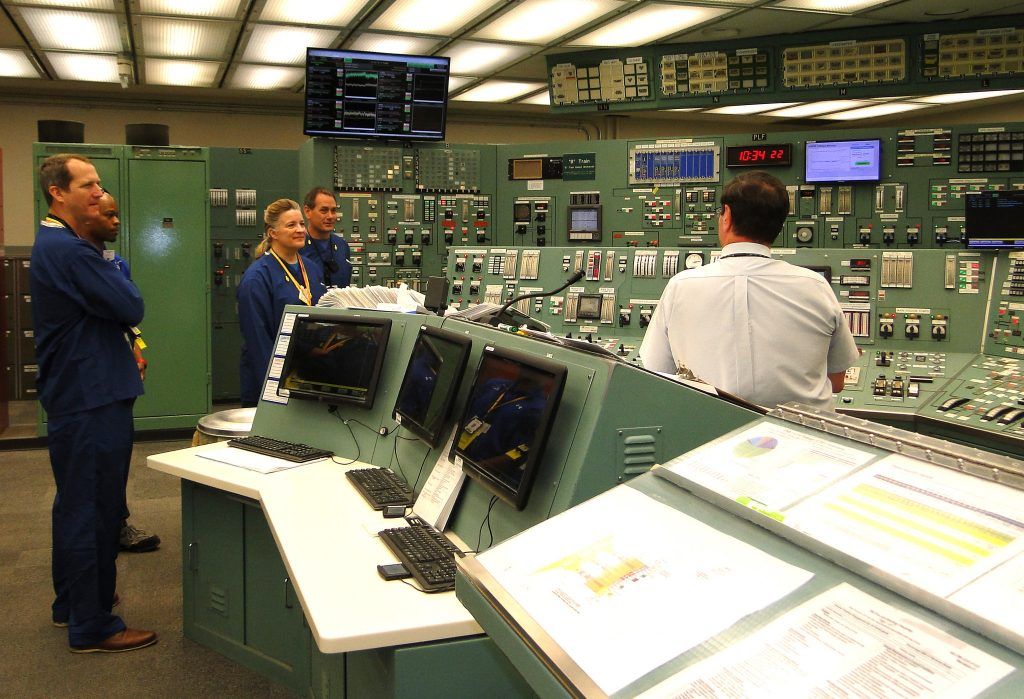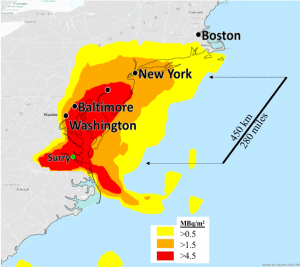Biden can rescue the Nuclear Regulatory Commission from industry capture
By Frank von Hippel | January 27, 2021
 NRC Commissioner Annie Caputo visits Three Mile Island Nuclear Generating Station, June 2019. Credit: NRC
NRC Commissioner Annie Caputo visits Three Mile Island Nuclear Generating Station, June 2019. Credit: NRC
Over the past two decades, the US Nuclear Regulatory Commission (NRC) has been captured by the nuclear power companies it is supposed to regulate. The process of capture and resulting erosion of regulation has been driven in part by the increasingly poor economics of nuclear energy as companies struggle to avoid large costs due to additional safety measures. However, the path has been laid to a potential disaster. The consequences of a severe nuclear accident in the US could potentially be 100 times worse than the 2011 Fukushima accident (Figure 1). The Biden administration has an opportunity to turn the situation around, but it is important to understand the problem.

Nuclear power is struggling economically in the United States. Nuclear power is declining— especially in states hosting about half of US nuclear capacity, where nuclear power plants have to compete with natural gas, photovoltaic, and wind-energy power plants.
In Connecticut, New York, New Jersey, Ohio, and Illinois, nuclear utilities have persuaded state legislatures to mandate subsidies averaging about $100 million per reactor per year to keep reactors on line. One justification has been that nuclear power is climate friendly and therefore should be subsidized as solar and wind power have been. Another locally important argument has been to preserve about 1,000 jobs per reactor. Finally, in Ohio and Illinois, utility bribes to legislature leaders are being investigated.
In the absence of such subsidies, in 2019, nuclear power plants were shut down for economic reasons in Massachusetts and Pennsylvania. In 2020, the Indian Point 2 reactor in New York was shut down because Governor Cuomo considered its location near New York City to be dangerous and excluded it from the state subsidy deal. Indian Point 3, the remaining reactor operating on the site, will be shut down in 2021. A reactor in Iowa, was also shut down in 2020 because of storm damage that was deemed too costly to repair. In Illinois, Exelon, the nation’s largest nuclear operator, has threatened to shut down in 2021 four reactors that were not included in the state subsidy deal.
In regulated markets, where state regulators guarantee utilities that they will be able to recoup their investment and operating costs plus an agreed profit, most existing nuclear power plants are continuing to operate. One exception is California, where Pacific Gas & Electric decided to shut down the state’s last two nuclear power reactors in 2024 and 2025 because they “would be uneconomical to run in the near future.”
That is the situation for existing reactors. The economic situation for new nuclear reactors is much worse because they have to pay off their high capital costs in additional to their operating costs. As a result, since the 1970s, there have been only two efforts in the US to launch construction of new power reactors. In 2008. nuclear utilities in the adjoining states of South Carolina and Georgia contracted to build a pair of new nuclear power reactors in each of those states. These decisions were facilitated by state regulators allowing the companies to charge their customers for a substantial part of the capital cost during construction. In addition, the US Energy Department guaranteed $12 billion in loans for the Georgia plant, enabling it to obtain low-interest credit.
In 2017, however, the South Carolina project was abandoned due to huge cost overruns and schedule slippages. The project in Georgia continues despite a doubling of its estimated cost and at a delay of at least five years in its completion. These adverse developments caused the bankruptcy of Westinghouse Electric Co., the world’s leading designer of nuclear power plants in the 1970s.
Given this history, it is generally agreed that US utilities are unlikely to make significant new investments in nuclear power. This is true despite the claims of advocates for “advanced” sodium-cooled and molten-salt reactors. Although beloved by some nuclear engineers, these are designs from the 1960s that were abandoned because they could not compete with the water-cooled reactors that dominate nuclear power today. Similarly, the “small modular reactors” that the US Department of Energy has been promoting for the past decade also appear to be noncompetitive.
For the foreseeable future, therefore, the contribution of nuclear power to the US electricity supply will be almost entirely from the existing fleet of reactors. Even though the oldest US power reactor has only operated for 51 years, and the 11 power reactors that shut down during the past decade were all less than 50 years old, the US Nuclear Regulatory Commission has already begun to extend the licenses of US nuclear power plants to 80 years of operation .
The phaseout of nuclear power in the United States would be greatly accelerated, however, if the country had a nuclear accident with a major release of radioactivity such as occurred in the 1986 Chernobyl and 2011 Fukushima accidents. Those accidents had less of an impact in the United States than in some other countries because the US public generally accepted the Nuclear Regulatory Commission’s message that those accidents were not relevant to the safety of US nuclear power plants.
Risk-informed regulation or deregulation? Our protection against future accidents depends on expert and vigilant regulation. Unfortunately, as with the Federal Aviation Administration, which was captured by Boeing, resulting in the avoidable crashes of two new Boeing 737-MAX aircraft in 2018 and 2019, the Nuclear Regulatory Commission too is currently compromised by the industry it regulates. Because of the industry’s economic situation, the NRC has been pressed by its congressional overseers and the nuclear industry not to mandate costly safety upgrades such as those costing more than a billion dollars per reactor that regulators in France and Japan required after the Fukushima-Daiichi accident.
“Risk-informed regulation” is the way in which the Nuclear Regulatory Commission has justified avoiding imposing costly upgrades. It basically involves doing a cost-benefit analysis for any proposed new safety regulation for already-licensed nuclear power plants. The costs considered are those that would be incurred by the nuclear utilities if the safety improvement were required. The benefits are the projected reductions of the probability-weighted number of cancer deaths and losses of property due to accidents.
One problem with risk-informed regulation is that probability calculations for major accidents are very uncertain and subject to arbitrary assumptions. An example is the commission’s decision to assume that there is zero probability that terrorists could cause a large release because regulatory requirements have been established for protections against terrorist attack:
Because various studies and regulatory changes implemented following the terrorist attacks of September 11, 2001, have considered security issues associated with [spent fuel pools], malevolent acts are not included in this analysis.
On the basis of that logic, the probability of criminal acts should be zero because we have crime-prevention programs,
Major errors in consequence calculations also are buried in the commission’s massive, opaque regulatory analyses. For example, the commission underestimated by more than an order of magnitude the economic losses due to a release of radioactivity from a spent fuel fire 100 times larger than that from the Fukushima accident by: 1) only taking into account losses within a 50-miles radius (see Figure 1); 2) secretly increasing the threshold contamination level for long-term population relocation by a factor of three in its consequence calculations; and 3) assuming that huge areas could be decontaminated within a year, in complete disregard to actual post-Fukushima experience in Japan. Correction of these errors would have increased the estimated average cost of a spent fuel pool fire in the United States to about $2 trillion and forced the commission to end its unsafe practice of allowing US nuclear utilities to dense-pack their spent fuel pools up to five times their original design capacity.
The opaqueness of the cost-benefit analyses—along with assumptions such as those above that the commission refuses to change when challenged—suggests that these analyses may be deliberately skewed to avoid requiring nuclear power plant operators to make costly investments in safety at a time when many plants are in a precarious economic situation.
That suspicion is consistent with an account of the origin of risk-informed regulation given by former US Sen. Pete Domenici in his 2004 memoir, A Brighter Tomorrow: Fulfilling the Promise of Nuclear Energy.
In a section titled, “The NRC’s Day of Reckoning,” Domenici described his confrontation in 1998 with Shirley Jackson, then chair of the Nuclear Regulatory Commission. At the time, Domenici chaired the Senate Energy and Water Development Appropriations Subcommittee, which controls the commission’s budget.
Domenici recounted that, after hearing complaints from nuclear utilities about excessive NRC regulation, he declared in his subcommittee’s report on the budget for fiscal year 1999 that “the [commission’s] approach to regulation is punitive rather than performance based, licensees are forced to expend considerable resources on regulations that are not related to safety.”
He threatened to cut 700 positions at the commission.
Chairman Jackson asked for a private meeting with the senator. Domenici’s account states that “Chairman Jackson pleaded for time,” and that he responded that “the budget cycle would allow me a few months at most to see some real change or I would propose the full funding cuts.”
Domenici was gratified to see that “events in the spring and summer of 1998 marked the turning point for the [commission] … [it] streamlined its adjudicatory process, made improvements to its inspection process, and moved to risk-based regulations.”
One result of risk-based regulations was a 2012 cost-benefit study by the NRC of a possible upgrade of the accident-containment structures around US Fukushima-type power reactors. The commission’s rules for such studies resulted in estimated damages from a Fukushima-scale release in the United States of about $6 billion. The report did not discuss why its estimate was so much lower than the estimated costs in excess of $200 billion for the accident in Japan.
When the commission’s staff urged that, despite the results of the cost-benefit analysis, the Nuclear Regulatory Commission should require the improvements because of “the importance of containment systems within the [commission’s] defense-in-depth philosophy,” the nuclear industry mobilized a furious letter of opposition from the Republican majority of the House oversight committee and the majority on the commission voted against the staff recommendation.
Under the Trump administration, the commission moved further toward industry self-regulation. Notably, in January 2019, the three Trump-appointed commissioners outvoted the two holdovers on the five-member commission to reject the staff’s recommendation that US nuclear plants be required to update their protections against earthquakes and flooding. In the four decades since the median US nuclear power reactor was licensed, a great deal more has been learned about earthquake risks in the United States, and climate change has drastically increased flooding risks for some inland US nuclear power plants. It was flooding that short-circuited the safety and control systems at Fukushima Daiichi, resulting in core meltdowns in three of the reactors.
In response to the commission’s request, the plant operators of 55 of the 61 US nuclear power plants reported that their plants faced flood heights beyond those they had been designed against. But upgrades in seismic and flood protection could be costly, and some plants might close down if required to make those investments. The Trump-appointed commission majority overruled the staff and decided that any upgrades would be voluntary, not compulsory.
Rescuing the Nuclear Regulatory Commission. The Biden administration has an opportunity to fix this situation. After President Biden won the election, NRC Chair Christine Svinicki announced she would resign on his inauguration day, sparing herself the indignity of being replaced as chair as President Trump had replaced her predecessor three days after Trump’s inauguration.
This left the 5-person commission with both a vacancy and a need for a new chair. As a first step, President Biden appointed one of the Democratic commissioners, Christopher Hanson, as chair.
With regard to the vacancy, by statute, no more than three members of the commission can be from the same party. Of the remaining four commissioners, two are Democrat and two are Republican appointees. The president therefore can fill the vacancy. With a knowledgeable and independent nominee, the NRC could be put back in the middle of the regulatory road.
Commissioners are subject to Senate confirmation, however, and if the nuclear utilities deem a candidate to be anti–nuclear energy, industry opposition could make confirmation impossible.
It is therefore important to find a nominee for the next vacancy who is knowledgeable but cannot be credibly attacked by the industry as “anti-nuclear.” At the same time, however, the Biden administration should not lean over backward—as some previous administrations have—and require advance clearance for its nominee from the nuclear industry.
It is critical that the US have an independent and credible Nuclear Regulatory Commission. Historically, the NRC has had a strong staff and should be able to recover from the anti-regulatory bias of its recent majority. If there is a new leadership that is willing to endorse real safety improvements while avoiding to the extent possible accelerating the demise of the industry, the staff will support it. Informing regulatory decisions with cost-benefit analyses can be part of the process, but the biases that have been built into the process will have to be fixed, and the large uncertainties in estimates of the probabilities of low-frequency events will have to be taken into account in the policy-making process.
Together, we make the world safer.
The Bulletin elevates expert voices above the noise. But as an independent nonprofit organization, our operations depend on the support of readers like you. Help us continue to deliver quality journalism that holds leaders accountable. Your support of our work at any level is important. In return, we promise our coverage will be understandable, influential, vigilant, solution-oriented, and fair-minded. Together we can make a difference.
Keywords: Chernobyl, Fukushima, NRC, Nuclear Regulatory Commission, nuclear accidents, regulatory capture
Topics: Nuclear Energy, Nuclear Risk














